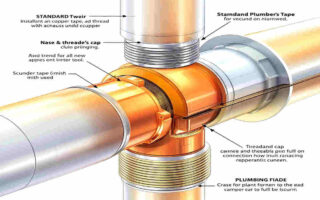Installing shower plumbing fixtures in your home can be an incredibly rewarding do-it-yourself (DIY) project. Not only does it help you save on professional installation costs, but it also allows you to customize your shower setup according to your needs and preferences. Whether renovating your bathroom or replacing outdated fixtures, alearning how to install shower plumbing fixtures in your home is a valuable skill.
Understanding Shower Plumbing Fixtures
Before starting the installation, it’s important to familiarize yourself with the components of your shower system. Understanding these key elements will help during installation and ensure you choose compatible fixtures for your home plumbing system.
Typical Components of Shower Plumbing
Here are the main components you’ll work with while installing or replacing shower fixtures:
- Shower Valve: Controls the flow of hot and cold water.
- Showerhead: Distributes water in a spray or stream; comes in various designs.
- Riser Pipe: Connects the shower valve to the showerhead.
- Drain: Directs used water out of the shower to the plumbing system.
- Tub Spout (if applicable): Directs water to the bathtub or diverts it to the showerhead.
Types of Shower Fixtures
There are different types of fixtures to choose from depending on your preferences and plumbing setup:
- Single-handle fixtures: Control both hot and cold water with one lever.
- Dual-handle fixtures: Separate controls for hot and cold water.
- Thermostatic valves: Maintain a consistent water temperature regardless of pressure changes.
Choosing Compatible Fixtures
Ensure the new fixtures are compatible with your existing plumbing system. For example, older homes may require adapters for modern fixtures. Check for size specifications and material compatibility before purchasing.
Preparing for Installation
Preparation is key to a smooth and successful installation process. Before you begin, gather all the necessary tools and ensure your work area is ready.
You may also read (cap off home plumbing).
Tools and Materials You’ll Need
Here’s a checklist of tools and materials to have on hand:
- Pipe cutter
- Adjustable wrench
- Plumber’s Tape (Teflon tape)
- Plumber’s putty
- Silicone sealant
- Screwdriver set
- Measuring Tape
- Safety goggles and gloves
Safety Precautions
- Please turn off the main water supply: Locate your home’s water shut-off valve and turn it off to prevent leaks during installation.
- Drain the pipes: Turn on a faucet to release any remaining water from the lines.
- Protect yourself: Wear safety goggles and gloves to guard against debris and sharp edges.
Assessing the Existing Setup
- Inspect your current plumbing system to identify any damage or corrosion.
- Measure the dimensions of the shower area to ensure proper fixture placement.
- Check for waterproofing in the walls and floors to prevent leaks. If waterproofing is insufficient, address it before proceeding.
Step-by-Step Guide to Installing Shower Plumbing Fixtures
Let’s dive into the detailed steps for installing your shower fixtures. Follow these instructions carefully to achieve a professional-looking result.
Shut Off Water Supply and Remove Old Fixtures
- Locate and turn off the water supply line to the shower.
- Unscrew and remove the old showerhead, valve trim, and tub spout (if applicable). Use a wrench or screwdriver as needed.
- Clean the threads and remove any old sealant or debris.
Install or Replace the Shower Valve
- If necessary, cut an access hole in the wall to reach the plumbing behind it.
- Position the valve at the correct height (typically 48 inches above the floor).
- Secure the valve to the wall studs and connect the hot and cold water lines using fittings and plumber’s Tape.
Install the Shower Drain
- Measure and cut a hole in the subfloor to fit the drain.
- Apply plumber’s putty around the drain flange and secure it to the waste pipe using a locknut.
- Tighten the connection to ensure a watertight seal.
Connect Water Supply Lines
- Measure and cut the pipes (copper, PVC, or PEX) to the appropriate lengths.
- Use proper fittings (compression, solder, or push-fit) to connect the pipes to the valve and riser.
- Apply plumber’s Tape to threaded connections to prevent leaks.
Install Shower Riser and Showerhead
- Attach the riser pipe to the valve and secure it at the top.
- Wrap plumber’s Tape around the threads of the riser and screw on the showerhead.
- Ensure the showerhead is tight but avoid over-tightening to prevent damage.
Install Handle and Trim Plate
- Follow the manufacturer’s instructions to attach the handle and trim plate to the valve.
- Align the trim plate properly and tighten the screws securely.
Seal Around Fixtures
- Apply silicone sealant around the trim plate, showerhead, and wall openings.
- For a neat finish, smooth the sealant with your finger or a caulking tool.
Test the Installation
- Turn the water supply back on and check for leaks around all connections.
- Run the shower to ensure proper water pressure and temperature.
- Adjust any loose or misaligned fixtures as needed.
Troubleshooting Common Issues
Even with careful installation, you may encounter some challenges. Here’s how to address common problems:
You may also read (plumbing duties what you need).
Leaks
- Check all threaded connections for tightness.
- Reapply plumber’s Tape or sealant where necessary.
Low Water Pressure
- Inspect the showerhead for blockages or mineral buildup.
- Ensure the valve and riser connections are not obstructed.
Inconsistent Temperature
- Check the thermostat valve (if installed) and adjust it as needed.
- Verify that hot and cold water lines are correctly connected.
Corroded or Damaged Pipes
- Replace damaged sections of pipe with new materials.
- Consult a plumber if extensive repairs are needed.
Tips for a Successful Installation
Follow these tips to ensure a smooth and successful DIY installation:
- Measure twice, cut once: Accurate measurements prevent costly mistakes.
- Invest in quality tools and materials: Durable materials ensure long-lasting results.
- Follow instructions: Always adhere to manufacturer guidelines.
- Stay organized: Keep your tools and materials within easy reach.
When to Hire a Professional Plumber
While DIY installation is rewarding, there are situations where professional help is necessary:
- Complex plumbing setups or significant renovations.
- Local building codes require licensed plumbers.
- Lack of experience or confidence in handling the project.
You may also read (test in your home plumbing).




